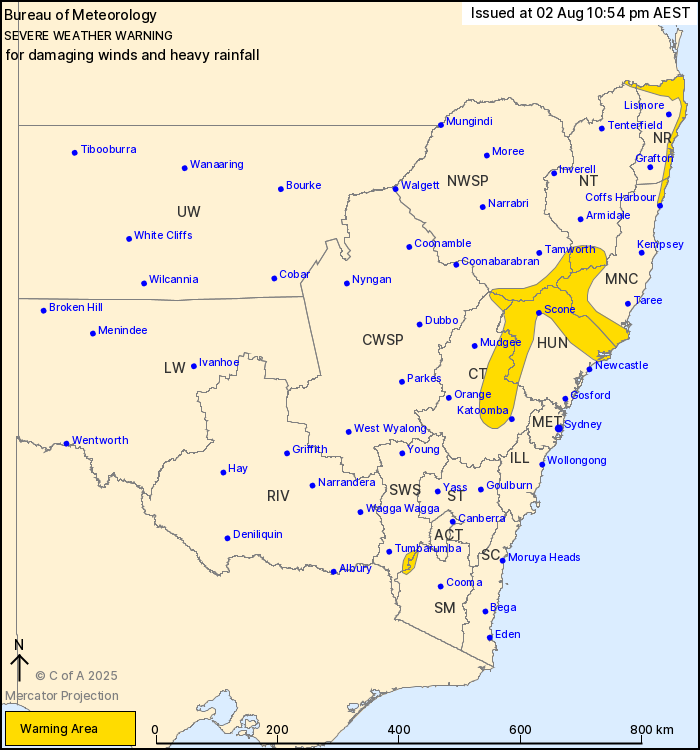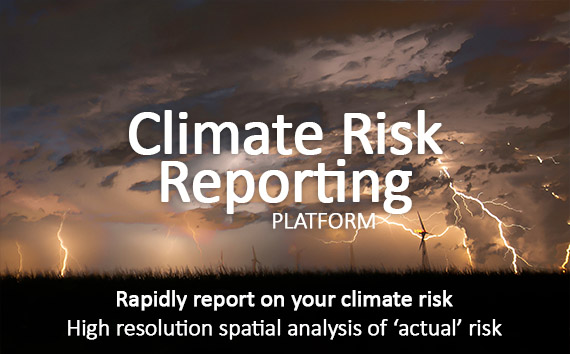Source: Bureau of Meteorology
For people in parts of Northern Rivers, Mid North Coast, Hunter,
Central Tablelands, North West Slopes and Plains, Northern
Tablelands, Central West Slopes and Plains, South West Slopes and
Snowy Mountains Forecast Districts.
Issued at 10:54 pm Saturday, 2 August 2025.
Damaging winds and heavy rainfall ongoing about central eastern
NSW, with damaging winds developing in the northeast on
Sunday.
Weather Situation: A strong east to southeasterly flow with
persistent rain continues about central eastern parts of the state
tonight despite the weakening of a low pressure system to the
north. A second low pressure system currently in the Coral Sea will
rapidly deepen offshore of the NSW and Queensland border on Sunday
afternoon, bringing further strong south to southeasterly flow over
northeast NSW.
For parts of the HUNTER, MID NORTH COAST and NORTHERN and CENTRAL
TABLELANDS: DAMAGING WINDS averaging 55 to 65 km/h, with peak gusts
of around 90 km/h, are possible over elevated areas until late
Sunday morning. HEAVY RAINFALL which may lead to FLASH FLOODING is
also forecast parts of the Hunter and southern parts of the Mid
North Coast. Six-hourly rainfall totals between 40 and 60 mm are
likely, with isolated totals up to 70 mm possible about elevated
areas. Heavy rainfall is expected to ease by the early hours of
Sunday morning.
For AREAS NORTH OF COFFS HARBOUR: Strong southerly winds averaging
50 to 60 km/h, with DAMAGING WIND GUSTS of around 90 km/h, are
possible about the coastal fringe between Coffs Harbour and Tweed
Heads and elevated parts of the Border Ranges from mid-afternoon on
Sunday. Winds are forecast to ease below warning thresholds by late
Sunday night.
For the SNOWY MOUNTAINS: Southeasterly DAMAGING WINDS averaging 60
to 70 km/h with peak gusts of around 100 km/h are possible over
alpine areas above 1400 metres until early Sunday morning.
Flood Watches and various Flood Warnings are current for eastern
catchments and a Coastal Hazard Warning is also current. Please
refer to http://www.bom.gov.au/nsw/warnings/
Locations which may be affected include Coffs Harbour, Scone,
Murwillumbah, Byron Bay, Ballina, Yamba, Woolgoolga, Mullumbimby,
Brunswick Heads, Evans Head, Hastings Point, Numinbah and
Cabramurra.
104 km/h wind gust was recorded at Norah Head at 6:00 pm.
104 km/h wind gust was recorded at Nobby's Signal Station at 4:19
pm.
96 km/h wind gust was recorded at Kempsey Airport at 2:23
pm.
Sustained 74 km/h winds were recorded at Cabramurra around 8:00
pm, with a 93 km/h wind gust at 7:53pm.
Sustained 70 km/h winds were recorded at Nobby's Signal Station
(Newcastle) around 7:00 pm.
The State Emergency Service advises that people should:
* Don't drive, ride or walk through flood water.
* Keep clear of creeks and storm drains.
* If you are trapped by flash flooding, seek refuge in the highest
available place and ring 000 if you need rescue.
* Be aware that run-off from rainfall in fire affected areas may
behave differently and be more rapid. It may also contain debris
such as ash, soil, trees and rocks.
* After bushfires, heavy rain and the loss of foliage can make the
ground soft and heavy, leading to a greater chance of
landslides.
* Move vehicles under cover or away from trees.
* Secure or put away loose items around your house, yard and
balcony.
* Keep at least 8 metres away from fallen power lines or objects
that may be energised, such as fences.
* Trees that have been damaged by fire are likely to be more
unstable and more likely to fall.
* Report fallen power lines to either Ausgrid (131 388), Endeavour
Energy (131 003), Essential Energy (132 080) or Evoenergy (131 093)
as shown on your power bill.
* Stay vigilant and monitor conditions. Note that the landscape
may have changed following bushfires.
* For emergency help in floods and storms, ring your local SES
Unit on 132 500.

02/Aug/2025 01:01 PM



